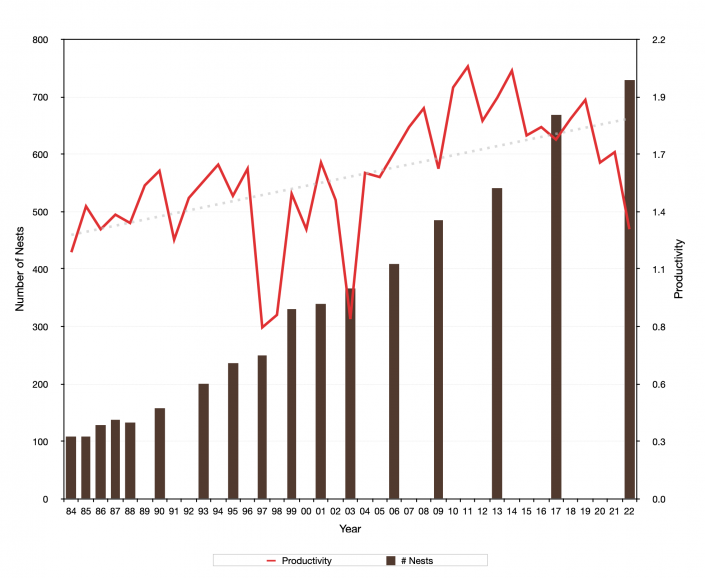New Jersey Osprey Population Continues to Grow Despite Low Productivity
by Ben Wurst / Senior Wildlife Biologist





We’re proud to release results of the 2022 New Jersey Osprey Project Survey, which documented the greatest number of nesting ospreys in the history of the project. Overall, surveys by staff and loyal volunteers recorded a total of 733 occupied nests throughout the state. The majority of ospreys (83%) continue to nest along the Atlantic coast of New Jersey with the remainder nesting along the Delaware Bay and inland locations. Surveys recorded the outcome of 73% of the known population, which allows us to present these results with confidence.
Of the 555 nests where the outcome was determined, those pairs produced a total of 720 young for a statewide average productivity rate of 1.30 young/active (known-outcome) nest, which is the lowest recorded since 2003 (0.86). Only two of twelve colonies (Northwest NJ and Monmouth County) had an increase in productivity over the rolling five year average. All other colonies had reduced productivity in 2022. The Delaware Bay colonies had higher productivity (1.81) than the Atlantic coastal colonies (1.16), which has been the pattern over the past 20+ years.
As we reported in a previous blog post on the subject, adverse spring weather affected osprey productivity in New Jersey this year. A nor’easter, which hit the area in early May, brought strong onshore winds, moderate coastal flooding and precipitation. This made it very difficult for ospreys (males in particular) to find and catch prey. This was witnessed throughout much of the Atlantic Coast and even documented at the Barnegat Light Osprey Cam, where an experienced 16 year old male osprey, named Duke, has nested since 2018. Last year, viewers watched live as he was gone for hours at a time and returned with no prey. This forced the female to leave her nest and eggs to forage for herself. When her eggs were left exposed, a pair of crows attempted to predate them. Luckily, this pair was still successful in producing two young who later fledged, but we believe that many pairs lost eggs from avian predators. Overall, around 200 pairs failed to produce young.
Despite the reduced productivity last year, we continue to see the osprey population thrive and expand range. Band re-sightings and recoveries show that ospreys are living long, productive lives. In addition, there continue to be suitable structures to support new nests, like debris on coastal saltmarshes and dead/dying trees. The availability of prey does not appear to be limiting the size and growth of the population as well. Their collective health is an indicator that we are doing a good job of protecting our aquatic ecosystems, which support a huge amount of biodiversity along the coast. Our only concern is future effects from climate change, like more frequent and longer lasting nor’easters and reduced prey availability, that could cause more widespread nest failures and lower productivity. All more reason to continue monitoring ospreys…

Monitoring and maintaining a stable osprey population is a fundamental goal of the New Jersey Osprey Project, which will be marking its 50th anniversary this year. We hope to conduct more outreach to engage with residents and visitors to tell the story of New Jersey’s ospreys and how they are a symbol of a healthy coast. Thank you to all of our volunteers who survey nests throughout the state, our members and donors who contribute to this project, and our project partners who help support our work. Your gracious support is most appreciated!
- For full results, check out the 2022 New Jersey Osprey Project Report
- Donate to support our work
- Learn more about the NJ Osprey Project
Discover more from Conserve Wildlife Foundation of NJ
Subscribe to get the latest posts sent to your email.